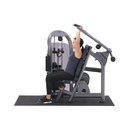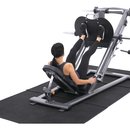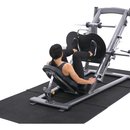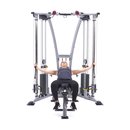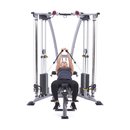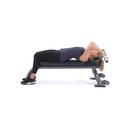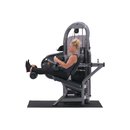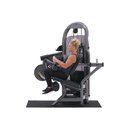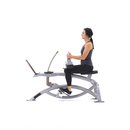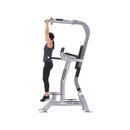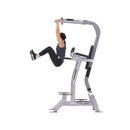Many people think that if you want to lose fat, you should do more cardio, and that if you want to build muscle, you should lift weights. But it's not that simple. You can use weight training to lose fat, and in some ways it's actually better than cardio.
Falling for the common misconception that you need to do cardio to lose weight is one of the biggest mistakes you could make and could hinder your progress.
Weight Training Increases Short-Term Calorie Burn
The first reason we are going to give weight training a point in the fat-loss war against cardio is due to the calorie burn after the workout is completed.

Studies have demonstrated that after a weight-training workout, metabolism can be boosted for up to 38 hours post-workout.[1] This means that rather than burning, say, 60 calories an hour while sitting and watching TV, you're burning 70. While you may not think that 10 extra calories is a big deal, when you multiply this by 38 hours, you can see what a huge difference it can make in your daily calorie expenditure.
When you figure that out on a monthly rate, it becomes even clearer how regular participation in weight training will really increase your capacity to burn calories, and thus fat.
With cardio training, you might get an extra 40-80 calories burned after a moderately paced session, but this will depend upon the exact intensity and duration of the workout. In order to generate a high amount of post-calorie burn from aerobics, you'd have to be doing it for a very long duration of time.
Sprinting is a slightly different story and will create effects with your metabolic rate closer to that of weight lifting, so that's something to consider as well. However, you must be sprinting hard in order to see the benefits, which is something some people struggle with.
Weight Training Increases Long-Term Calorie Burn
The second factor to consider in the fat-loss war is long-term metabolic increases. While it's great to be burning more calories for 38 hours after the workout, that's not going to help you two weeks from now, unless you are consistent with your workout program (which you should be, but that's not the point we're trying to make here).
What weight training will enable you to do is build up a larger degree of lean muscle mass, which then basically serves as a calorie-burning powerhouse in the body.
When you calculate your basal metabolic rate, which is how many calories you would burn if you stayed in bed all day and did absolutely nothing except breathe, one of the factors that goes into this is your total body weight. The most accurate equations will also take into account lean body mass, which represents your muscles, bones, and organs.
The more muscle you have on your body, the higher this rate will be and the better the calorie-burning results you will obtain 24/7.[2]
Since muscle tissue is fairly stable (as long as there is some stimulus on the muscle and you are consuming enough protein, it won't be lost), this proves to be an effective long-term strategy for losing body fat.
This is the primary reason males can typically eat more than females without gaining weight—they have more lean muscle mass on their body, thus they are burning more calories around-the-clock.
To add to this point, it's critical that you are realistic with how much muscle mass you can build in a given period of time. Naturally, males will be able to generate between 1-2 pounds of pure muscle mass in a given month and females will get about half that, around 0.5-1 pound. Over time, though, with consistent effort, this will make you dramatically more resistant to weight gain as you grow older, making it extremely beneficial.
Weight Training and Total Body Reshaping
Another big benefit that weight training has over cardio training is that it will allow you to completely reshape your body. Cardio training will generally help you lose weight, however, this weight loss is typically a combination of fat and muscle, so what you're left with is a smaller version of your current self.
When you are performing resistance training, while following a calorie-restricted diet, then you stand a better chance of losing strictly body fat, while helping to enhance the natural curves of your body.[3]
This will give you a much better overall transformation than if you just lost weight doing cardio. If you've ever noticed someone who has lost a considerable amount of weight but still looks somewhat "soft," that's usually why—they have lost some fat, but their muscles aren't overly toned.
Weight Training for Women
Here’s an example of a full-body resistance-training workout:
Cardio and Calorie Burn
One issue you're more than likely thinking about is the different calorie burns during the actual workout—that's got to count for something, right?
Correct! If you do a longer cardio session, you could burn somewhere in the neighborhood of 500-800 calories, depending on the exact length and intensity level. That is a fairly decent number and will definitely help with your fat-loss goals.
Since you must burn off 3,500 calories in order to lose one pound of body fat, if you do enough of these cardio sessions, and make sure you're keeping track of your macronutrient intake, weight loss will take place.

But, keep in mind that you are going to have to keep doing those long cardio sessions. Time will likely become a big factor with this one, and boredom could start to play a role over time, too.
While a weight-training session may not burn as many calories per minute during the actual workout (although that can depend on how intense the weight lifting is), the overall calorie-burning benefits you receive from it typically outweigh those of cardio.
Cardio and Health Benefits
One point does have to go to cardio for health benefits. Obviously strength training has health benefits as well, but cardio training has a bigger influence on cardiovascular health, since your heart and lungs work harder for longer when you do it.[4]
So, while you likely shouldn't entirely eliminate cardio from your fat-loss training program, you should be putting forth good effort toward weight training as well. Overlooking this form of exercise while playing the fat-loss game is a big mistake that's going to hurt your progress.
Conclusion
It's time to break free from the thinking that cardio equates to fat loss and weight training equates to building muscle and weight gain. It's simply not as clear cut as that. While doing cardio can help your fat-loss goals, in a lot of ways weight training is more effective and will also give you a more toned body shape.
While lifting weights can help you build muscle mass, that muscle mass will in turn help you lose fat mass. And if you just want to lose fat and don't want to get hugely muscular, don't worry, that takes a lot of concentrated effort and won't happen just by showing up to the weight room a few times a week.
If losing fat is your goal, lifting weights can only help you, so make it a priority.
References
- Schuenke, M. D., Mikat, R. P., & McBride, J. M. (2002). Effect of an acute period of resistance exercise on excess post-exercise oxygen consumption: implications for body mass management. European Journal of Applied Physiology, 86(5), 411-417.
- Stiegler, P., & Cunliffe, A. (2006). The role of diet and exercise for the maintenance of fat-free mass and resting metabolic rate during weight loss. Sports Medicine, 36(3), 239-262.
- Bryner, R. W., Ullrich, I. H., Sauers, J., Donley, D., Hornsby, G., Kolar, M., & Yeater, R. (1999). Effects of resistance vs. aerobic training combined with an 800 calorie liquid diet on lean body mass and resting metabolic rate. Journal of the American College of Nutrition, 18(2), 115-121.
- Fletcher, G. F., Blair, S. N., Blumenthal, J., Caspersen, C., Chaitman, B., Epstein, S., ... & Piña, I. L. (1992). Statement on exercise: benefits and recommendations for physical activity programs for all Americans-a statement for health professionals by the Committee on Exercise and Cardiac Rehabilitation of the Council on Clinical Cardiology, American Heart Association. Circulation, 86(1), 340.





